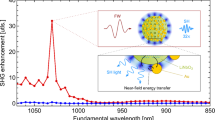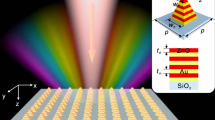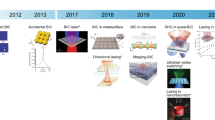Metamaterials have a tremendous potential for applications from biophotonics to optical circuits, although progress has been hampered by intrinsic metal losses. This Review discusses the progress in countering such losses through the use of gain media to realize devices such as nanoplasmonic lasers or improved metamaterials for imaging and nonlinear optical applications.
Abstract
Optical metamaterials and nanoplasmonics bridge the gap between conventional optics and the nanoworld. Exciting and technologically important capabilities range from subwavelength focusing and stopped light to invisibility cloaking, with applications across science and engineering from biophotonics to nanocircuitry. A problem that has hampered practical implementations have been dissipative metal losses, but the efficient use of optical gain has been shown to compensate these and to allow for loss-free operation, amplification and nanoscopic lasing. Here, we review recent and ongoing progress in the realm of active, gain-enhanced nanoplasmonic metamaterials. On introducing and expounding the underlying theoretical concepts of the complex interaction between plasmons and gain media, we examine the experimental efforts in areas such as nanoplasmonic and metamaterial lasers. We underscore important current trends that may lead to improved active imaging, ultrafast nonlinearities on the nanoscale or cavity-free lasing in the stopped-light regime.
This is a preview of subscription content, access via your institution
Access options
Subscribe to this journal
Receive 12 print issues and online access
$259.00 per year
only $21.58 per issue
Buy this article
- Purchase on Springer Link
- Instant access to full article PDF
Prices may be subject to local taxes which are calculated during checkout






Similar content being viewed by others
References
Novotny, L. & Hecht, B. Principles of Nano-Optics (Cambridge Univ. Press, 2006).
Maier, S. A. Plasmonics: Fundamentals and Applications (Springer, 2007).
Fleischmann, M., Hendra, P. J. & McQuillan, A. J. Raman spectra of pyridine absorbed at a silver electrode. Chem. Phys. Lett. 26, 163–166 (1974).
Jeanmaire, D. L., Van Duyne, R. P. & Sloan, A. P. Surface Raman spectroelectrochemistry: Part I. Heterocyclic, aromatic, and aliphatic amines absorbed on the anodized silver electrode. J. Electroanal. Chem. 84, 1–20 (1977).
Albrecht, M. G. & Creighton, J. A. Anomalously intense Raman spectra of pyridine at a silver electrode. J. Am. Chem. Soc. 99, 5215–5217 (1977).
Ebbesen, T. W., Genet, C. & Bozhevolnyi, S. I. Surface-plasmon circuitry. Phys. Today 61, 44–50 (May 2008).
Barnes, W. L., Dereux, A. & Ebbesen, T. W. Surface plasmon subwavelength optics. Nature 424, 824–830 (2003).
Ozbay, E. Plasmonics: Merging photonics and electronics at nanoscale dimensions. Science 311, 189–193 (2006).
Novotny, L. & van Hulst, N. Antennas for light. Nature Photon. 5, 83–90 (2011).
Giannini, V. et al. Controlling light localization and light–matter interactions with nanoplasmonics. Small 6, 2498–2507 (2010).
Cai, W. & Shalaev, V. M. Optical Metamaterials: Fundamentals and Applications (Springer, 2009).
Shalaev, V. M. Optical negative-index metamaterials. Nature Photon. 1, 41–48 (2007).
Soukoulis, C. M., Linden, S. & Wegener, M. Negative refractive index at optical wavelengths. Science 315, 47–49 (2007).
Pendry, J. B. Negative refraction makes a perfect lens. Phys. Rev. Lett. 85, 3966–3969 (2000).
Tsakmakidis, K. L., Boardman, A. D. & Hess, O. 'Trapped rainbow' storage of light in metamaterials. Nature 450, 397–401 (2007).
Pendry, J. B., Schurig, D. & Smith, D. R. Controlling electromagnetic fields. Science 312, 1780–1782 (2006).
Leonhardt, U. Optical conformal mapping. Science 312, 1777–1780 (2006).
Gansel, J. K. et al. Gold helix photonic metamaterials as broadband circular polarizer. Science 325, 1513–1515 (2009).
Rose, A., Huang, D. & Smith, D. R. Controlling the second harmonic in a phase-matched negative-index metamaterial. Phys. Rev. Lett. 107, 063902 (2011).
Zharov, A. A., Shadrivov, I. V. & Kivshar, Y. S. Nonlinear properties of left-handed metamaterials. Phys. Rev. Lett. 91, 037401 (2003).
Maier, S. Plasmonic field enhancement and SERS in the effective mode volume picture. Opt. Express 14, 1957–1964 (2006).
Boardman, A. D. (ed.) Electromagnetic Surface Modes (Wiley, 1982).
Raether, H. Surface Plasmons on Smooth and Rough Surfaces and on Gratings (Springer, 1988).
Soukoulis, C. M. & Wegener, M. Optical metamaterials — more bulky and less lossy. Science 330, 1633–1634 (2010).
Boltasseva, A. & Atwater, H. A. Low-loss plasmonic metamaterials. Science 331, 290–291 (2011).
Anlage, S. M. The physics and applications of superconducting metamaterials. J. Opt. 13, 024001 (2011).
Chen, H-T. et al. Tuning the resonance in high-temperature superconducting terahertz metamaterials. Phys. Rev. Lett. 105, 247402 (2010).
Berini, P. & De Leon, I. Surface plasmon–polariton amplifiers and lasers. Nature Photon. 6, 16–24 (2012).
Soukoulis, C. M. & Wegener, M. Past achievements and future challenges in the development of three-dimensional photonic metamaterials. Nature Photon. 5, 523–530 (2011).
Barnes, W. L. Fluorescence near interfaces: the role of photonic mode density. J. Mod. Opt. 45, 661–699 (1998).
Ramakrishna, S. A. & Pendry, J. B. Removal of absorption and increase in resolution in a near-field lens via optical gain. Phys. Rev. B 67, 201101(R) (2003).
Bergman, D. J. & Stockman, M. I. Surface plasmon amplification by stimulated emission of radiation: quantum generation of coherent surface plasmons in nanosystems, Phys. Rev. Lett. 90, 027402 (2003).
Giannini, V., Fernández-Domínguez, A. I., Heck, S. C. & Maier, S. A. Plasmonic nanoantennas: fundamentals and their use in controlling the radiative properties of nanoemitters. Chem. Rev. 111, 3888–3912 (2011).
Xiao, S. et al. Loss-free and active optical negative-index metamaterials. Nature 466, 735–738 (2010).
Wuestner, S., Pusch, A., Tsakmakidis, K. L., Hamm, J. M. & Hess, O. Overcoming losses with gain in a negative refractive index metamaterial. Phys. Rev. Lett. 105, 127401 (2010).
Fang, A., Koschny, Th. & Soukoulis, C. M. Self-consistent calculations of loss-compensated fishnet metamaterials. Phys. Rev. B 82, 121102(R) (2010).
Wuestner, S., Pusch, A., Tsakmakidis, K. L., Hamm, J. M. & Hess, O. Gain and plasmon dynamics in active negative-index metamaterials. Phil. Trans. R. Soc. A 369, 3525–3550 (2011).
Hamm, J. M., Wuestner, S., Tsakmakidis, K. L. & Hess, O. Theory of light amplification in active fishnet metamaterials. Phys. Rev. Lett. 107, 167405 (2011).
Zheludev, N. I., Prosvirnin, S. L., Papasimakis, N. & Fedotov, V. A. Lasing spaser. Nature Photon. 2, 351–354 (2008).
Pusch, A., Wuestner, S., Hamm, J. M., Tsakmakidis, K. L. & Hess, O. Coherent amplification and noise in gain-enhanced nanoplasmonic metamaterials: A Maxwell-Bloch Langevin approach. ACS Nano 6, 2420–2431 (2012).
Wuestner, S. et al. Control and dynamic competition of bright and dark lasing states in active nanoplasmonic metamaterials. Phys Rev B 85, 201406(R) (2012).
Valentine, J. et al. Three-dimensional optical metamaterials with a negative refractive index. Nature 455, 376–379 (2008).
Zhang, S. et al. Near-infrared double negative metamaterials. Opt. Express 13, 4922–4930 (2005).
Hur, K. et al. Three-dimensionally isotropic negative refractive index materials from block copolymer self-assembled chiral gyroid networks. Angew. Chem. Int. Ed. 50, 11985–989 (2011).
Hess, O. & Gehrig, E. Photonics of Quantum-Dot Nanomaterials and Devices: Theory and Modelling (Imperial College Press, 2011).
Böhringer, K. & Hess, O. A full time-domain approach to spatio-temporal dynamics of semiconductor lasers: I. theoretical formulation. Prog. Quantum Electron. 32, 159–246 (2008).
Böhringer, K. & Hess, O. A full time-domain approach to spatio-temporal dynamics of semiconductor lasers: II. spatio-temporal dynamics. Prog. Quantum Electron. 32, 247–307 (2008).
Cook, J. J. H., Tsakmakidis, K. L. & Hess, O. Ultralow-loss optical diamagnetism in silver nanoforests. J. Opt. A 11, 114026 (2009).
Meinzer, N. et al. Arrays of Ag split-ring resonators coupled to InGaAs single-quantum-well gain. Opt. Express 18, 24140–24151 (2010).
Smith, D. R., Schultz, S., Markoš, P. & Soukoulis, C. M. Determination of effective permittivity and permeability of metamaterials from reflection and transmission coefficients. Phys. Rev. B 65, 195104 (2002).
Stockman, M. I. The spaser as a nanoscale quantum generator and ultrafast amplifier. J. Opt. 12, 024004 (2010).
Rockstuhl, C. et al. Resonances of split-ring resonator metamaterials in the near infrared. Appl. Phys. B 84, 219–227 (2006).
Husnik, M. et al. Absolute extinction cross-section of individual magnetic split-ring resonators. Nature Photon. 2, 614–617 (2008).
Stockman, M. I. Criterion for negative refraction with low optical losses from a fundamental principle of causality. Phys. Rev. Lett. 98, 177404 (2007).
Stockman, M. I. Spaser action, loss-compensation, and stability in plasmonic systems with gain. Phys. Rev. Lett. 106, 156802 (2011).
Wuestner, S., Pusch, A., Tsakmakidis, K. L., Hamm, J. M. & Hess, O. Comment on 'Spaser action, loss-compensation, and stability in plasmonic systems with gain'. Phys. Rev. Lett. 107, 259701 (2011).
Pendry, J. B. & Maier, S. A. Comment on 'Spaser action, loss-compensation, and stability in plasmonic systems with gain'. Phys. Rev. Lett. 107, 259703 (2011).
De Leon, I. & Berini, P. Amplification of long-range surface plasmons by a dipolar gain medium. Nature Photon. 4, 382–387 (2010).
Gather, M. C., Meerholz, K., Danz, N. & Leosson, K. Net optical gain in a plasmonic waveguide embedded in a fluorescent polymer. Nature Photon. 4, 457–461 (2010).
Sorger, V. J. et al. Experimental demonstration of low-loss optical waveguiding at deep sub-wavelength scales. Nature Commun. 2, 331 (2011).
Hill, M. T. et al. Lasing in metal-insulator-metal sub-wavelength plasmonic waveguides. Opt. Express 17, 11107–11112 (2009).
Oulton, R. F. et al. Plasmon lasers at deep-subwavelength scale. Nature 461, 629–632 (2009).
Noginov, M. A. et al. Demonstration of a spaser-based nanolaser. Nature 460, 1110–1112 (2009).
Ma, R-M., Oulton, R. F., Sorger, V. J., Bartal, G. & Zhang, X. Room-temperature sub-diffraction-limited plasmon laser by total internal reflection. Nature Mater. 10, 110–113 (2011).
Genov, D. A., Oulton, R. F., Bartal, G. & Zhang, X. Anomalous spectral scaling of light emission rates in low-dimensional metallic nanostructures. Phys. Rev. B 83, 245312 (2011).
Vogelgesang, R. & Dmitriev, A. Real-space imaging of nanoplasmonic resonances. Analyst 135, 1175–1181 (2010).
Sonnefraud, Y., Koh, A. L., McComb, D. W. & Maier, S. A. Nanoplasmonics: engineering and observation of localized plasmon modes. Laser Photon. Rev. 6, 277–295 (2011).
Koh, A. L., Fernández-Domínguez, A. I., McComb, D. W., Maier, S. A. & Yang, J. K. W. High-resolution mapping of electron-beam-excited plasmon modes in lithographically defined gold nanostructures. Nano Lett. 11, 1323–1330 (2011).
Prodan, E., Radloff, C., Halas, N. & Nordlander, P. A hybridization model for the plasmon response of complex nanostructures. Science 302, 419–422 (2003).
Ringler, M. et al. Shaping emission spectra of fluorescent molecules with single plasmonic nanoresonators. Phys. Rev. Lett. 100, 203002 (2008).
Kéna-Cohen, S. et al. Plasmonic sinks for the selective removal of long-lived states. ACS Nano 5, 9958–9965 (2011).
Luk'yanchuk, B. et al. The Fano resonance in plasmonic nanostructures and metamaterials. Nature Mater. 9, 707–715 (2010).
Giannini, V., Francescato, Y., Amrania, H., Phillips, C. C. & Maier, S. A. Fano resonances in nanoscale plasmonic systems: a parameter-free modelling approach. Nano Lett. 11, 2835–2840 (2011).
Francescato, Y., Giannini, V. & Maier, S. A. Plasmonic systems unveiled by Fano resonances. ACS Nano 6, 1830–1838 (2012).
Nie, S. & Emory, S. R. Probing single molecules and single nanoparticles by surface-enhanced Raman scattering. Science 275, 1102–1106 (1997).
Anker, J. N. et al. Biosensing with plasmonic nanosensors. Nature Mater. 7, 442–453 (2008).
Kneipp, K. et al. Single molecule detection using surface-enhanced Raman scattering (SERS). Phys. Rev. Lett. 78, 1667–1670 (1997).
Hill, R. T. et al. Leveraging nanoscale plasmonic modes to achieve reproducible enhancement of light. Nano Lett. 10, 4150–4154 (2010).
Anger, P., Bharadwaj, P. & Novotny, L. Enhancement and quenching of single-molecule fluorescence. Phys. Rev. Lett. 96, 113002 (2006).
Liebermann, T. & Knoll, W. Surface-plasmon field-enhanced fluorescence spectroscopy. Colloid Surf. 171, 115–130 (2000).
Kinkhabwala, A. et al. Large single-molecule fluorescence enhancements produced by bowtie nanoantenna. Nature Photon. 3, 654–657 (2009).
Kano, H. & Kawata, S. Two-photon-excited fluorescence enhanced by a surface plasmon. Opt. Lett. 21, 1848–1850 (1996).
Palomba, S. & Novotny, L. Nonlinear excitation of surface plasmon polaritons by four-wave mixing. Phys. Rev. Lett. 101, 056802 (2008).
Danckwerts, M. & Novotny, L. Optical frequency mixing at coupled gold nanoparticles. Phys. Rev. Lett. 98, 026104 (2007).
Dionne, J. A., Lezec, H. J. & Atwater, H. A. Highly confined photon transport in subwavelength metallic slot waveguides. Nano Lett. 6, 1928–1932 (2006).
Dionne, J. A., Sweatlock, L. A., Atwater, H. & Polman, A. Plasmon slot waveguides: towards chip-scale propagation with subwavelength-scale localization. Phys. Rev. B 73, 035407 (2006).
Oulton, R. F., Sorger, V. J., Genov, D. A., Pile, D. F. P. & Zhang, X. A hybrid plasmonic waveguide for subwavelength confinement and long-range propagation. Nature Photon. 2, 496–500 (2008).
Walther, C., Scalari, G., Amanti, M. I., Beck, M. & Faist, J. Microcavity laser oscillating in a circuit-based resonator. Science 327, 1495–1497 (2010).
Yu, K., Lakhani, A. M. & Wu, M. C. Subwavelength metal-optic semiconductor nanopatch lasers. Opt. Express 18, 8790–8799 (2010).
Nezhad, M. P. et al. Room-temperature subwavelength metallo–dielectric lasers. Nature Photon. 4, 395–399 (2010).
Ma, R-M., Oulton, R. F., Sorger, V. J. & Zhang, X. Plasmon lasers: coherent light source at molecular scales. Laser Photon. Rev. http://dx.doi.org/10.1002/lpor.201100040 (2012).
Khurgin, J. B. & Sun, G. Practicality of compensating the loss in plasmonic waveguides using semiconductor gain medium. Appl. Phys. Lett. 100, 011105 (2012).
Tanaka, K., Plum, E., Ou, J. Y., Uchino, T. & Zheludev, N. I. Multifold enhancement of quantum dot luminescence in plasmonic metamaterials. Phys. Rev. Lett. 105, 227403 (2010).
Zheludev, N. I. The road ahead for metamaterials. Science 328, 582–583 (2010).
Smith, D. R. et al. Limitations on subdiffraction imaging with a negative refractive index slab. Appl. Phys. Lett. 82, 1506–1508 (2003).
Pendry, J. B. & Ramakrishna, S. A. Focusing light using negative refraction J. Phys. Condens. Matter 14, 6345–6364 (2003).
Kirby, E. I., Hamm, J. M., Pickering, T. W., Tsakmakidis, K. L. & Hess, O. Evanescent gain for slow and stopped light in negative refractive index heterostructures. Phys. Rev. B 84, 041103(R) (2011).
Tsakmakidis, K. L. & Hess, O. Extreme control of light in metamaterials: complete and loss-free stopping of light. Physica B 10.1016/j.physb.2012.01.093http://dx.doi.org/10.1016/j.physb.2012.01.093 (2012).
Jacob, Z. & Shalaev, V. M. Plasmonics goes quantum. Science 334, 463–464 (2011).
Yamamoto, Y. & Slusher, R. E. Optical processes in microcavitites. Phys. Today 46, 66–73 (June 1993).
Oulton, R. F. Surface plasmon lasers: sources of nanoscopic light. Mater. Today 15, 592–600 (January–February 2012).
Sorger, V. J. et al. Strongly enhanced molecular fluorescence inside a nanoscale waveguide gap. Nano Lett. 11, 4907–4911 (2011).
Dionne, J. A., Diest, K., Sweatlock, L. A. & Atwater, H. A. PlasMOStor: a metal-oxide-Si field effect plasmonic modulator. Nano Lett. 9, 897–902 (2009).
Author information
Authors and Affiliations
Corresponding author
Ethics declarations
Competing interests
The authors declare no competing financial interests.
Rights and permissions
About this article
Cite this article
Hess, O., Pendry, J., Maier, S. et al. Active nanoplasmonic metamaterials. Nature Mater 11, 573–584 (2012). https://doi.org/10.1038/nmat3356
Published:
Issue Date:
DOI: https://doi.org/10.1038/nmat3356
This article is cited by
-
Compensating losses in polariton propagation with synthesized complex frequency excitation
Nature Materials (2024)
-
Hydrogel muscles powering reconfigurable micro-metastructures with wide-spectrum programmability
Nature Materials (2023)
-
A Perfect Absorber for Ultra-long-wave Infrared Based on a Cross-Shaped Resonator Structure
Plasmonics (2023)
-
Surface plasmon optical sensor based on multilayer metal-coated nanorods resonator
Journal of Optics (2023)
-
Breaking the fundamental scattering limit with gain metasurfaces
Nature Communications (2022)



